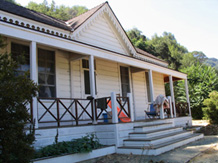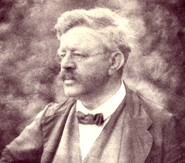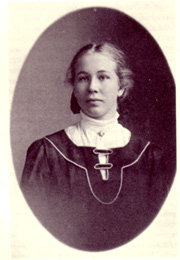Hidden Villa in Los Altos Hills is a non-profit educational organization,
its mission being to inspire studying and sustaining the environment,
and promoting social justice. The valley in which Hidden Villa
is located was originally inhabited by Ohlone Indians. Franciscan
missionaries were the first Europeans, and planted an olive tree
grove visible today.
 The "White House," originally a stage coach house, is
the oldest building on the property. Passengers from San Jose
would stop in Mountain View, stay overnight in the White House,
and continue to Pescadero the following day.
The "White House," originally a stage coach house, is
the oldest building on the property. Passengers from San Jose
would stop in Mountain View, stay overnight in the White House,
and continue to Pescadero the following day.
A large house on the property was completed in 1930 by Frank and
Josephine Duveneck. The Duvenecks were Boston aristocrats.
 Frank
Duveneck's father Frank Senior was a noted American artist and
art teacher.
Frank
Duveneck's father Frank Senior was a noted American artist and
art teacher.
Frank Duveneck, Senior, ca. 1915
Frank Junior was born in 1886, but his mother Elizabeth, also
an artistic talent, died when he was only two. Frank Senior left
Frank Junior in the care of Elizabeth's aunt in Waltham, Massachusetts.
 Josephine
(neé Whitney) was the daughter of Henry M. Whitney, who
established the first electric transportation system in the United
States in 1888.
Josephine
(neé Whitney) was the daughter of Henry M. Whitney, who
established the first electric transportation system in the United
States in 1888.
Josephine's mother Margaret Green Whitney, 21 years younger than
Josephine's father and from a much less affluent family, pushed
her children to enter Boston society. Josephine, born April 12,
1891, the last of five children, was her father's favorite.
Josephine Whitney and Frank Duveneck met at a "coming out"
party. They would not meet again for two years, but Frank had
resolved to marry Josephine as soon as he saw her. Frank earned
a master's degree in engineering at Harvard, and was working about
60 hours weekly for $60 monthly, not much for a Boston aristocrat,
but he had taken the job to be near Josephine, as she learned
later.
Josephine was striving for independence from her family, particularly
from her mother, and was about to go to New York when Frank asked
her to marry him. She turned him down, then reconsidered. Frank's
low-key persistence was rewarded when Frank and Josephine married
in June 1913.
After a brief honeymoon in the Adirondack Mountains, New York
State, the newlywed Duvenecks embarked on a long voyage, sailing
from Canada to England, then France, Germany, and Italy. Returning
to Boston, they headed for western United States. In California
they visited Josephine's sister Laura near Santa Barbara, then
went up to San Francisco, which they found unlike any other city
in the U.S. or Europe: "Two Bostonians at the Golden Gate
in 1913 really had their eyes opened."
The Duvenecks had lost their hearts to California, but they continued
across the Pacific to the Orient, which neither of their well-off
families had ever seen. After a 21-day voyage they were in Japan,
then Korea and China, the latter just after the Boxer rebellion.
Returning to the U.S., they found Josephine's father reduced to
bankruptcy by unsuccessful ventures, but concocting new schemes.
Back home in Massachusetts they were having dinner with Josephine's
sister Ruth in August, 1914 when they heard that England had declared
war on Germany. It took a while for the realization to sink in
that the peaceful era in which they had been born and raised had
ended.
The Duvenecks' first child, daughter Elizabeth, was born in April,
1915. In 1917 the Duvenecks were living in Lowell, Massachusetts,
where Frank was working on a special engineering project at the
Merrimac Mills. Their second child Francis was born in September.
When the New England winter set in, they found that their rented
ramshackle house was utterly inadequate. Winds blew out the curtains,
a hot water bottle froze overnight, and the children were sick.
Having seen California, and wanting to get some distance from
their overbearing relatives, the family left for California in
April, 1917.
The Duvenecks' first home was near Santa Barbara, which was ordinarily
pleasant, but a massive fire in the hills created stifling temperatures.
The family took a train to Monterey, where Josephine and the children
were recuperating when Frank telephoned to say he had rented a
beach cottage at "sort of a funny place" - Carmel. Carmel,
small and isolated as it was, got caught up in war fever when
the United States entered the "Great War," as World
War I was then called.
Frank was a pacifist, but enlisted in a California Signal Service
regiment where his engineering skill would be useful, and was
assigned to Camp Lewis in Washington State. He taught Josephine
how to drive, in a Ford Model T, before leaving. Josephine and
the children joined Frank in Tacoma in November 1917 and settled
into a house he had rented. After a dreary winter, during which
he was promoted to Master Sergeant Electrician, Frank was sent
to the European theatre. Along the way in Massachusetts he saw
his father for the last time.
Eight months pregnant with their third child, Josephine moved
with the children to Palo Alto and rented a house at Addison and
Cowper streets. Daughter Hope was born in May 1918. Josephine
was obliged to leave her children in another's care to go to Cincinnati,
Ohio to settle her father-in-law into a hospice; an inveterate
smoker, Frank Senior had cancer.
Returning to Palo Alto just as World War I ended, Josephine bought
a five-bedroom house on Newell Road just outside Palo Alto city
limits for $7,500. She had written Frank in Europe for his approval,
but the letter not having arrived, the first he heard was a second
letter with "Well, I bought the house." Frank, serving
in the army of occupation in Germany, did not get home until August,
1919. He saw Hope for the first time, and renewed ties with the
older children.
Click here
for Part 2
